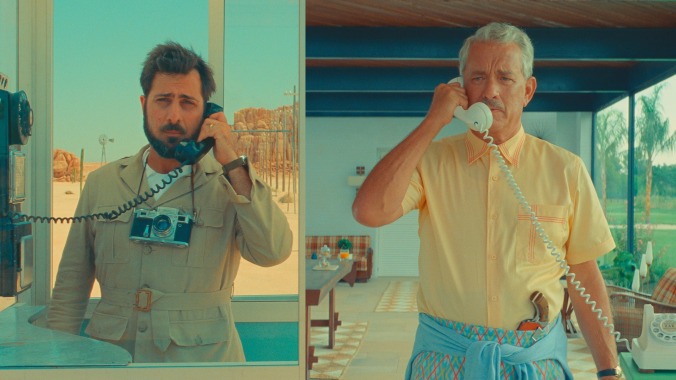Asteroid City review: Wes Anderson encounters 1950s stargazers, actors, and one peculiar alien
Jason Schwartzman, Scarlett Johansson, and Tom Hanks lead a starry cast in this beautiful but rather empty endeavor

Wes Anderson is still using many of his old tricks. His latest, the 1955 set Asteroid City, will feel familiar to anyone who has seen any of his previous movies. It has many eccentric characters who all speak in monotone and a few carry around a precious prop that obviously means much to them and defines their character. A camera around the neck or a notebook and pen in the hand or back pocket. There’s some sort of narrator only tangentially related to the film’s main story. That plot is many layered; it’s about a play within a TV show within the film. The sets and costumes are intricately detailed and there’s always something sumptuous to look at on screen. Familiar things can be good, but can they maintain their appeal for decades?
Jason Schwartzman is the man with the camera, Augie Stenbeck, a worldly and successful photojournalist. He’s also a widower whose wife just died and he’s traveling with his 14-year-old son and three younger daughters to the titular fictional city. The son, Woodrow (Jake Ryan), he of the ever present notebook, is one a few teenage stargazers who have gathered in this small Southwest town for a space convention. Each of the five has distinguished themselves in their exploration and inventions and are here to be awarded. Along for the ride come an assortment of parents and teachers plus the townspeople who run the one hotel, manage a military compound, and an observatory where the ceremony for the five young geniuses is taking place.
These characters are played by actors—old and new to Anderson—like Scarlett Johansson, Tilda Swinton, Tom Hanks, Hope Davis, Steve Carrell, Liev Schriber, Jeffrey Wright, Rupert Friend and Maya Hawke. But that’s not all. You see this story is actually a play and all these people are characters in the play. It doesn’t stop there. Edward Norton is the playwright, a mid-last century American genius, perhaps a Tennessee Williams or an Arthur Miller type. Bryan Cranston appears as a narrator in a TV documentary being made about the playwright and his latest production. Not to mention that catalyst event that emotionally disturbs all these people is a visit by an alien entity.
There’s a lot of detail and many characters but what’s it all about? Stenbeck’s grief for his wife, his tetchy relationship with her dad (Hanks) and growing attraction to Johansson’s movie star, Midge Sinclair, is one narrative thread. Norton’s playwright and his creative struggle is another. Various characters fall in love or make connections. Yet because of the structure of the film—the story within the story—none of them feel urgent or especially resonant. There are moments of brilliance both from the performers and from the writing. But they never cohere together into a complete story. Some of the threads are resolved off screen, some aren’t resolved at all. Just as the audience is getting invested in one story or the other, Anderson goes into a new and completely separate tangent.
One breathtaking diversion features Schwartzman as Jones Hall, the actor playing Stenbeck, delivering a stunning audition to Norton’s playwright that ends up with the two men making a deeper connection both personally and professionally. Both actors are marvelous reacting to each other and the audience is swept away in the moment. Schwartzman, in particular, elevates this and many other scenes, absolutely making the most of playing the lead character.
Matching him is Johansson who adapts her performance to fit Anderson’s style by underplaying. Hawke and Friend make for a beguiling young couple who begin to tentatively fall in love. Their performances are told completely physically; just by the way they look at each and inhabit the space between their characters. In a smaller role Adrien Brody offers a funny poignant portrait of the mad tortured artist. Hong Chau joins him for one melancholy scene infused with so much story that one wishes this was a subplot that Anderson made more of.
As this is an Anderson production, his collaborators on camera (Robert D. Yeoman), costumes (Milena Canonero) and production design (Adam Stockhausen) all deliver impeccable work. Fully detailed and ravishing to the eye, every frame looks like a tableau come to life. In particular the relationship between Stenbeck and Sinclair is told in conversations as they sit apart, each in their room but talking to each other through their windows. Stunning to look at and yet the fact that they are always at such distance away from each other hints at why the film remains at a remove.
Anderson builds gorgeous worlds. They are filled with such detail that there’s always something to marvel at. Yet narratively Asteroid City doesn’t fully come together. It remains a beautiful artifact but, despite a few moments of resonant storytelling, is too easily forgettable.
Asteroid City opens in select theaters on June 16 and in theaters everywhere on June 23